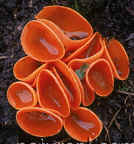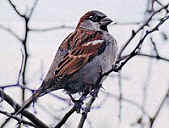Countryside Rangers Diary
December
December can often be quite a wet month, but why not get your wellies on, what better antidote for the festive season than a December walk in the park.
Flocks of feeding finches, frost lingering in the shadows of the woodlands and the washed out colours of a December afternoon are a tranquil counterpoint to tinsel and wrapping paper. And don't forget that, after the last of the Turkey curry a landmark will have slipped past- the shortest day. Before long, lengthening days will trigger new growth.
What's about in December?
 Birds have fewer daylight hours to feed
Birds have fewer daylight hours to feed- Foxes become noisy as their breeding season begins
- Brown hares are easier to spot in the short grass
- Small mammals and birds seek out warmth in houses, outbuildings and sheds
- The bright orange-peel fungus can be spotted on dead branches in the woods
- Male robins sing to mark out their territories
 Mammals are now protected from the cold by their thick winter coats; these often look quite different from their summer ones. Foxes appear particularly striking, their thick coats makes them look much bulkier than they actually are. The fallow deer seem much duller-more of a grey brown than a warm chestnut; their spots are much less distinct.
Mammals are now protected from the cold by their thick winter coats; these often look quite different from their summer ones. Foxes appear particularly striking, their thick coats makes them look much bulkier than they actually are. The fallow deer seem much duller-more of a grey brown than a warm chestnut; their spots are much less distinct.
 Watch for goldfinches visiting the fruit heads of dead teasels. With longer and narrower bills than other finches goldfinches are able to get at the seeds. An area of teasels can act as and important feeding resource for a flock throughout the winter. An abundance of seed along the farm trail encourages finches to abandon their territory and form mixed flocks. Usually these contain a few hundred birds but if conditions worsen these flocks can collect together resulting in enormous flocks, which move over several good feeding areas. The abundance of beech mast this year will delight chaffinches and the occasional brambling. Buntings sometimes feed together in large groups, but usually join flocks of finches. Because there are so many pairs of eyes watching for danger, feeding in a flock is safer than foraging alone.
Watch for goldfinches visiting the fruit heads of dead teasels. With longer and narrower bills than other finches goldfinches are able to get at the seeds. An area of teasels can act as and important feeding resource for a flock throughout the winter. An abundance of seed along the farm trail encourages finches to abandon their territory and form mixed flocks. Usually these contain a few hundred birds but if conditions worsen these flocks can collect together resulting in enormous flocks, which move over several good feeding areas. The abundance of beech mast this year will delight chaffinches and the occasional brambling. Buntings sometimes feed together in large groups, but usually join flocks of finches. Because there are so many pairs of eyes watching for danger, feeding in a flock is safer than foraging alone.
Sparrow numbers fall by 25 per cent in a year…….. The astonishing decline of the house sparrow in London goes on and on, new figures reveal the true story. A further 25 per cent drop followed the 59 per cent decrease in numbers between 1994 and 2000, when many Londoners saw sparrows disappear from their gardens, between 2000 and 2001, according to the British Trust for Ornithology. The new figures, announced in the trust's magazine, come from its 2001 breeding bird survey, which covers large tracts of Britain, and last year covered 54 sq km (21 sq miles) in London. This makes it even more important for us to put out bird feeders especially during the cold periods.
Christmas Tree Recycling Please recycle your tree this year. One in four British households buys a real Christmas tree (usually Norway spruce, Sitka spruce or Scots pine), a total of more than five million trees a year. Of these trees only a very small percentage are recycled. What better way to start the year than to have your tree recycled to be chipped for use as mulch or path dressing.